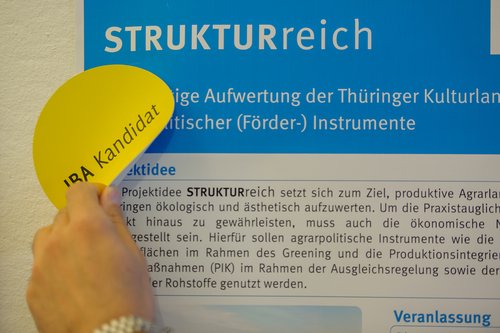Bauhaus-Universität Weimar an zahreichen IBA Kandidaten beteiligt
Am 30. September 2014 fiel die Entscheidung für die ersten Kandidaten der IBA Thüringen. Insgesamt wurden 16 von 248 eingereichten Projektideen als IBA Kandidaten nominiert. Die Bauhaus-Universität Weimar ist an insgesamt sechs ausgewählten Kandidaten als Projektpartner beteiligt.
Unter den Projekten sind die Themenfelder Stadtplanung, Wohnungsbau, Abwasserwirtschaft, Bauen im Bestand und Agrarpolitik vertreten.
Beteiligt sind folgende Professuren in nachfolgenden Projekten:
Professur Entwerfen und Wohnungsbau / Fakultät Architektur und Urbanistik
Bauen mit Weitblick. – Bezahlbar zusammen wohnen. Individualität zu Großserienpreisen.
Kommunale Wohnungsgesellschaft mbH Erfurt
Die kommunale Wohnungsgesellschaft Erfurt wird – in einem Pilotprojekt – in den nächsten Jahren rund 5.000 neue Wohnungen als Ersatz für bestehende Großstrukturen in 11- und 17- geschossiger Plattenbauweise realisieren. Die Grundlagen dafür werden mit einem Forschungs- und Planungsteam auf internationalem Niveau entwickelt.
Professur Siedlungswasserwirtschaft, Bauhaus-Institut für zukunftsweisende Infrastruktursysteme (b.is), Infrastrukturökonomie / Fakultät Bauingenieurwesen
Professur Industriedesign / Fakultät Gestaltung
Regionale und regenerative Stoffstromkreisläufe durch Abwassernutzung
Abwasserzweckverband Nordkreis Weimar
Die Idee des Projekts ist, die im Abwasser enthaltenen Ressourcen durch regenerative Energieerzeugung und Düngemittelproduktion zu nutzen. Entstehende Abwärme soll ortsnah verwertet werden. Dabei werden neue Formen und Prozesse der Aufgabenerledigung entwickelt.
bauhaus.ifex / Fakultät Architektur und Urbanistik
StadtLand Dornburg: Dornröschen erwache!
Stadt Dornburg-Camburg
Im Kern der Projektidee steht eine nachhaltige und gemeinschaftliche Entwicklung von Dornburg. Die Projektidee zielt auf eine feinfühlige, angemessene touristische Entwicklung dieses Saaletal-Abschnitts, eine bessere Anbindung des Ortsteils Dornburg sowie die Entwicklung als Wohnstandort. Die Aufgaben sind charakteristisch für den ländlichen Raum von Thüringen.
Professur Stadtplanung und Professur Städtebau I, Institut für Europäische Urbanistik, bauhaus.ifex, Fakultät Architektur und Urbanistik
StadtLandSchule (JENAplantypERFURTinWEIMAR): Umbau einer Typenschule in eine Schule der Zukunft
Stadt Weimar
Unter dem Begriff ‚StadtLandSchule’ soll ein Prototyp einer neuen Schule entstehen. In Verbindung mit dem Thüringer Schulmodell der Gemeinschaftsschule soll dieser ein zukunftsweisendes Modell für den Freistaat und vergleichbare Regionen sein. Hierfür soll eine unsanierte Typenschule in Plattenbauweise am Rande von Weimar umgebaut werden.
Professur Landschaftsarchitektur und Landschaftsplanung / Fakultät Architektur und Urbanistik
STRUKTURreich - Nachhaltige Aufwertung der Thüringer Kulturlandschaft unter Nutzung agrarpolitischer (Förder-) Instrumente
Thüringer Landesanstalt für Landwirtschaft (TLL)
Die Idee dieses Kandidaten ist, produktive Agrarlandschaften ökologisch und ästhetisch aufzuwerten und damit eine zukunftsfähige Bewirtschaftung und Gestaltung von Agrarlandschaften zu erproben. Dabei wird auf neue Anreizsysteme der aktuellen EU-Agrarförderung gesetzt.
Fachbereich Urbanistik (Resilienzforschung) / Fakultät Architektur und Urbanistik
Resilientes Schwarzatal - Experimentierfeld für regionale Wertschöpfungsketten, soziale Daseinsvorsroge, erneuerbare Energie, partizipative Strukturen
Die Projektidee besteht in der krisenfesten Entwicklung des Schwarzatals. Diese soll durch Forschungspartner und Kommunikationsformate begleitet werden.
Mit der Nominierung treten die IBA Kandidaten in eine Phase der Qualifizierung. Dabei arbeiten sie eng mit dem Team der IBA Thüringen und ggf. externen Beteiligten zusammen, um die Projektidee weiterzuentwickeln und zu schärfen. Ergebnis des gemeinsamen Qualifizierungsprozesses ist ein Projektdossier, das Voraussetzung für die Aufnahme als IBA Projekt ist. Der IBA Fachbeirat wird den Fortschritt der Ideen bewerten und seine Empfehlungen zur Nominierung der ersten IBA Projekte aussprechen. Erste Projekte werden im Jahr 2015 erwartet.
Weitere Informationen zu den IBA Kandidaten und den drei Erwartungsräumen, in denen die IBA Thüringen in den kommenden Monaten aktiv sein wird: www.iba-thueringen.de/kandidaten

